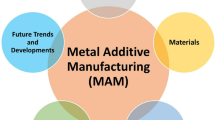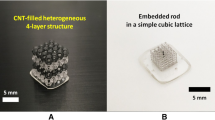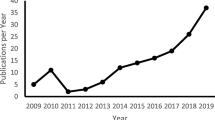Abstract
The concept of Hybrid Additive Manufacturing (Hybrid AM) finds a broad definition throughout different applications. For metal-based additive manufacturing the concept often refers to a combination of material deposition, e.g. through Laser Material Deposition (LMD) or other Directed Energy Deposition (DED) processes such as wire arc deposition or cold spray, with machining through milling. Multiple manufacturers have introduced machines implementing both milling and deposition processes based on different technologies.
Access provided by Autonomous University of Puebla. Download chapter PDF
Similar content being viewed by others
The concept of Hybrid Additive Manufacturing (Hybrid AM) finds a broad definition throughout different applications. For metal-based additive manufacturing the concept often refers to a combination of material deposition, e.g. through Laser Material Deposition (LMD) or other Directed Energy Deposition (DED) processes such as wire arc deposition or cold spray, with machining through milling. Multiple manufacturers have introduced machines implementing both milling and deposition processes based on different technologies (Andreas Gebhardt 2017; Xichun Luo and Yi Qin 2018).
Combinations of additive processes and other processing steps outside of an integrated machine system are also commonly considered as Hybrid AM. Such combinations can, for example, be multiple additive processes (Shin et al. 2018), conventionally manufactured precursors onto which features are added (Jan Bremer 2018) or serial processing steps similar to the integrated approach in multiple machines. Due to the wide range of combinable processes in such process chains (Michael P. Sealy et al. 2017), automation approaches are commonly customized to a selected range of processing steps and component types.
Benefits of Hybrid Additive Manufacturing range from lower cost due to smaller required raw components and reduced machining efforts to the possibility of local material combinations. Manufacturing components using Hybrid AM, especially to implement component features which differentiate otherwise identical components, also offers additional supply chain benefits (Fig. 13.1).
Flexible processing using both highly efficient conventional processes and additive processes where best suited permits a significantly reduced number of part variants during initial processing, reducing investment and logistics cost. As components are differentiated at a later stage of the process chain, lead times can be reduced and variant complexity can be reduced throughout the supply chain.
A wide range of technologies applicable in Hybrid Additive Manufacturing originate from the currently well-established applications of coating and repair using LMD. In different applications the combination of different processing steps to re-establish original performance is a regular occurrence, as for example in turbine blade repair. (Daniel Schraknepper and Marco Göbel 2015) In coating applications material combinations are used to achieve locally differing material properties (Fig. 13.2).
Exemplary process chain for automated adaptive turbine blade repair (TurPro 2013)
Due to the characteristics of welding processes and, in repair applications, the unknown condition of individual components, robustness of all processes along the process chain is required to achieve automation. So-called adaptive processes are enablers to achieve robust automated processes. This is commonly implemented through implementation of external (Jian Gao et al. 2005) or machine-integrated sensors (Bremer, Claus 1988) which measure component geometry and other properties to automatically adapt CNC programs to the individual component to be processed. Systems to adapt both the additive as well as other processes such as milling and grinding are available, mostly originating from repair applications. Solutions for stabilization of the individual processes through closed-loop control are also commonly applied (Gujin Bi 2004).
Research and development towards industrial implementation of Hybrid AM can be subdivided into two approaches regarding integration in process chains: horizontal process integration and vertical process integration, with horizontal process integration focusing on the implementation of multiple processing steps into one solution. Vertical integration of processes in Hybrid AM process chains focusses on the development of process solutions which can be integrated horizontally in a flexible manner through robust processes and suitable interfaces to neighboring processes both on physical and data layers.
Integration of the horizontal LMD-based Hybrid AM process chain into a single machine was investigated in the EU-funded research Project HyProCell (Juan Carlos Pereira et al. 2020).
Resulting benefits are high possible levels of automation, simpler component handling as well as a compact footprint for a given process chain. Integration of LMD processing, geometric measurement as well as machining capabilities and suitable software solutions in a commercial machine tool was demonstrated. A turbocharger component was manufactured using Hybrid AM. Based on a turned base ring, guide vanes were additively built using LMD. After machining of the top surface of the vanes, a laser-cut top ring was welded onto the component using laser-based heat transmission welding, completing the part. The component as well as the machine used in the project are depicted below (Fig. 13.3).
Integration of additive processes into distributed horizontal process chains for Hybrid AM requires high levels of robustness to permit high processing quality irrespective of variances from previous processes. Examples of such influences can be differing raw material quality or geometric deviations from nominal shape of the component to be processed.
Robust and cost-efficient vertical integration and automation of LMD processes was investigated in the BMBF-funded ProLMD project using robot-based system technology (Günter Neumann et al. 2021). Aspects such as raw material quality, effects of different shielding gas concepts, different robotic cell configurations and a digital process chain based on machine-integrated measurement of component geometry data were investigated.
Process stability and build quality in LMD processing is significantly influenced by geometric process parameters such as a correct working distance between laser beam, powder or wire nozzle and the substrate. By implementing machine-integrated component measurements and a toolpath planning algorithm based on measurement data of the component precise adherence to the geometrical process parameters can be ensured, increasing process stability and weld quality. Geometric data acquisition with a laser line scanner in one of the robotic LMD cells used in the ProLMD project is shown in Fig. 13.4.
Added process stability and geometric precision of the LMD-built volume were achieved by developing and implementing an intermittent geometry control approach in the ProLMD software package. Suitable process windows were investigated for layer height variation over feed rate variation with good weld quality. System-integrated geometry acquisition was used to automatically calculate localized feed rate adaption. Verification of the approach was conducted on a flat substrate with milled grooves of different depth and a cuboid target geometry. Resulting specimens and geometry measurements are depicted in Fig. 13.5.
LMD specimens built using geometric intermittent process adaption and measurement of resulting geometries during built (left) and without adaption (right) (Jan Bremer et al. 2020)
Implementation of the vertically integrated Hybrid AM process chain was verified on different robotic cells with varying payload, size, shielding gas concepts and cost. Local component modification, reinforcement and repair was demonstrated on components ranging from tooling through aerospace structures to aeroengine components. Materials ranging from Iron- and Nickel-base alloys to Titanium alloys were processed.
An example for such an application of local reinforcements to form openings on an aeroengine component is shown in Fig. 13.6 next to conventionally manufactured inspection openings. Through utilizing local build-up with Hybrid AM on forged blanks and subsequent post-machining cost savings of 13 to 26% were projected for such aerospace applications depending on process deposition rates (Günter Neumann et al. 2021).
Aerospace component with locally reinforced areas manufactured by Hybrid AM (Günter Neumann et al. 2021)
Increasing innovation in process automation and digitalization as well as control and sensorics are enablers to more time- and cost-efficient approaches toward Hybrid AM. Robust processes and integration of suitable interfaces on component, process and data level permit efficient and reconfigurable process chains. A growing range of industrially implemented examples of Hybrid AM is enabled by successful past and ongoing advances in research and development. Significant time and cost savings can be realized while giving increasing design and manufacturing freedom with significantly shortened lead times for derived variant manufacturing.
References
Andreas Gebhardt (2017) Additive Fertigungsverfahren: Additive Manufacturing und 3D-Drucken für Prototyping - Tooling – Produktion, Carl Hanser Verlag GmbH Co KG, 10.07.2017
Bremer Claus (1998) Automatic blade repair system based on reverse engineering strategies. American Society of Mechanical Engineers (Paper)
Daniel Schraknepper and Marco Göbel (2015) Fachlicher Abschlussbericht Aachener Innovationscluster AdaM – Adaptive Produktion für Ressourceneffizienz in Energie und Mobilität
Gujin Bi (2004) Identifizierung und Qualifizierung von prozessrelevanten Kenngrößen zur Überwachung und Regelung beim Laserauftragschweißen, Shaker Verlag
Günter Neumann et al. (2021) Prozess- und Systemtechnik zur Hybrid-Fertigung großer Bauteile mit dem Laser-Material-Deposition-Verfahren - Ergebnisbericht des BMBF Verbundprojektes ProLMD, Fraunhofer Publica, https://doi.org/10.24406/ilt-n-633180
Jan Bremer (2018) Overview of current research topics in (Hybrid-) Additive Manufacturing using LMD. International Laser Technology Congress Aachen
Jan Bremer et al. (2020) Adaptive manufacturing with laser material deposition using intermittent machine-integrated line scanning, CAMX Virtual Conference Proceedings, September 21–24
Jian Gao et al. (2005) Investigation of a 3D non-contact system based blade repair integration system. Aircraft Eng Aerospace Techn
Juan Carlos Pereira et al. (2020) Final Report HYPROCELL project - Development and validation of integrated multiprocess HYbrid PROduction CELLs for rapid individualized laser-based production, V8.00
Michael P Sealy et al. (2017) Hybrid processes in additive manufacturing. J Manuf Sci Eng 140(6)
TurPro (2013) – Fraunhofer-Innovationscluster Integrative Produktionstechnik für energieeffiziente Turbomaschinen, Fraunhofer ILT und Fraunhofer IPT, https://www.youtube.com/watch?v=2wmXVu5718Q
Xichun Luo and Yi Qin (2018) Hybrid Machining: Theory, Methods, and Case Studies, Academic Press, 27.06.2018
You Shin et al. (2018) Hybrid additive manufacturing of Al-Ti6Al4V functionally graded materials with selective laser melting and cold spraying. J Mater Proc Tech 255:650–655
Author information
Authors and Affiliations
Corresponding author
Editor information
Editors and Affiliations
Rights and permissions
Copyright information
© 2024 Springer-Verlag GmbH Germany, part of Springer Nature
About this chapter
Cite this chapter
Bremer, J., Gasser, A. (2024). Hybrid AM and Process Chains. In: Poprawe, R., Häfner, C., Wester, R. (eds) Tailored Light 2. RWTHedition. Springer, Cham. https://doi.org/10.1007/978-3-030-98323-9_13
Download citation
DOI: https://doi.org/10.1007/978-3-030-98323-9_13
Published:
Publisher Name: Springer, Cham
Print ISBN: 978-3-030-98322-2
Online ISBN: 978-3-030-98323-9
eBook Packages: EngineeringEngineering (R0)










